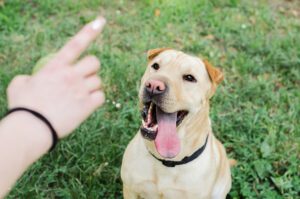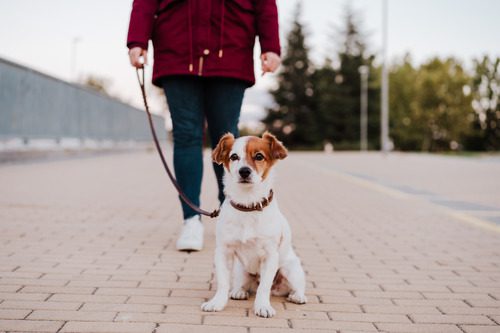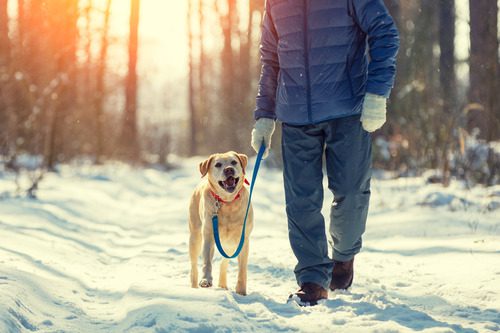Dog Training: 5 Easy Tricks to Teach Your Dog in Plymouth Meeting, PA
Training your dog is not only a fun bonding experience, but it also helps to stimulate their minds, reinforce good behavior, and improve communication between you and your furry friend. While there are countless tricks you can teach your dog, some are easier to learn and can be accomplished with patience and consistency. In this article, we will introduce five easy tricks to teach your dog that will impress your friends and family while providing mental and physical enrichment for your pet.

Five Easy Tricks
Below are 5 tricks that you can easily train your dog to do:
Sit
‘Sit’ is a fundamental command and often the first trick taught to dogs. This simple trick serves as a foundation for more advanced training and can help your dog learn to focus and respond to your cues.
How to Teach Your Dog to Sit:
- Hold a treat close to your dog’s nose
- Slowly raise the treat upward, allowing their head to follow the treat
- As their head moves up, their rear end should naturally lower into a sitting position
- Once your dog sits, say “sit,” give them the treat, and offer praise
- Practice this trick consistently, gradually reducing the use of treats as your dog becomes more responsive to the command
Shake
Teaching your dog to shake hands (or paws) is a simple trick that can be easily mastered with patience and positive reinforcement.
How to Teach Your Dog to Shake:
- Ask your dog to sit
- Hold a treat in your hand and present it to your dog, but keep it concealed in your fist
- When your dog shows interest in the treat, usually by sniffing or pawing at your hand, say “shake” and reward them with the treat and praise
- Over time, your dog will associate the word “shake” with the action of offering their paw. Gradually fade out the use of treats as your dog learns the command
Lie Down
The ‘lie down’ command is another fundamental trick that can help your dog develop better impulse control and relax in various situations.
How to Teach Your Dog to Lie Down:
- Ask your dog to sit
- Hold a treat in your hand and let your dog sniff it
- Slowly lower the treat to the ground while moving it away from your dog, encouraging them to stretch out and lower their body to the ground
- As your dog lies down, say “down” or “lie down,” give them the treat, and offer praise
- Practice this trick consistently, eventually removing the treats as your dog becomes more responsive to the command
Stay
Teaching your dog to ‘stay’ can be an invaluable skill, helping to keep them safe in various situations and improving their overall obedience.
How to Teach Your Dog to Stay:
- Ask your dog to sit or lie down
- Hold your hand out with your palm facing your dog and say “stay”
- Take a few steps back, maintaining eye contact with your dog
- If your dog remains in place, return to them, praise, and reward with a treat
- Gradually increase the distance and duration of the stay command as your dog becomes more comfortable and reliable with the trick
Roll Over
While slightly more advanced than the previous tricks, ‘roll over’ is a fun and impressive trick that can be mastered with practice and patience.
How to Teach Your Dog to Roll Over:
- Ask your dog to lie down
- Hold a treat close to your dog’s nose and slowly move it towards their shoulder, encouraging them to turn their head and follow the treat
- As your dog’s head turns, continue to move the treat in a circular motion, guiding them to roll onto their side and eventually onto their back
- Once your dog completes a full roll, say “roll over,” give them the treat, and offer praise
- Practice this trick consistently, gradually reducing the use of treats as your dog becomes more responsive to the command. Be patient, as this trick may take longer for some dogs to master
Additional Training Tips and Benefits
Training your dog is not only about teaching tricks, but it’s also about strengthening the bond between you and your pet and ensuring their overall well-being. Here are some additional tips and benefits to consider when training your dog:
Start Early
While it is never too late to train a dog, it is generally easier to start training when they are young. Young dogs tend to be more receptive to new experiences and have a higher capacity to learn. However, if you have an older dog, don’t be discouraged; with patience and dedication, you can still teach them new tricks and behaviors.
Use Positive Reinforcement
Positive reinforcement involves rewarding your dog with treats, praise, or playtime when they perform a desired behavior. This method encourages your dog to repeat the behavior, as they associate it with a positive outcome. Avoid punishment-based training methods, as they can lead to fear, anxiety, and a strained relationship with your pet.
Train in Short Sessions
Dogs have a limited attention span, so it is essential to keep training sessions short and focused. Aim for 5-10 minute sessions, 2-3 times a day. This approach will help maintain your dog’s interest and prevent them from becoming overwhelmed or frustrated.
Be Consistent
Consistency is crucial when training your dog. Make sure everyone in your household is on the same page regarding commands, rewards, and expectations. Inconsistent training can lead to confusion and slow down your dog’s progress.
Socialization
In addition to teaching tricks, it is essential to socialize your dog with other animals and people. Proper socialization helps prevent behavioral issues such as fear, aggression, and anxiety. Expose your dog to various environments, people, and animals in a positive and controlled manner to ensure they become well-rounded and confident.
Mental and Physical Stimulation
Training provides much-needed mental and physical stimulation for your dog. A well-exercised and mentally engaged dog is less likely to engage in destructive behaviors and will generally be happier and healthier.
Problem-Solving Skills
Teaching your dog new tricks and commands can help develop their problem-solving skills. As your dog learns to understand and respond to various commands, they will become more adaptable and better equipped to handle new situations and challenges.
Safety
Training your dog to respond to basic commands such as ‘sit,’ ‘stay,’ and ‘come’ can help keep them safe in various situations. A well-trained dog is less likely to run into traffic, get lost, or become involved in altercations with other animals.
By incorporating these tips into your training sessions and understanding the benefits of training, you can create a more enriching and enjoyable experience for both you and your dog. Training is an ongoing process, so continue to challenge your dog with new tricks and commands, ensuring they remain mentally and physically engaged throughout their life.
Follow the Dog Training Tips Above
Teaching your dog new tricks can be a fun and rewarding experience for both you and your pet. These five easy tricks – sit, shake, lie down, stay, and roll over – serve as excellent starting points for novice trainers and dogs alike. Remember that patience, consistency, and positive reinforcement are key components of successful dog training. With time and practice, your dog will not only learn these tricks, but they will also develop a stronger bond with you and gain a better understanding of your expectations. Don’t forget to have fun and enjoy the process of learning and growing together with your furry friend. For dog parents in the Plymouth Meeting, PA area, The Village Vets are available to serve you and your dog. Call us today at (484) 820-1700 if you have any questions, or if you would like to schedule an appointment.
Recent Posts
About The Village Vets
The Village Vets of Plymouth Meeting offers excellent service to clients in a comfortable, friendly atmosphere. To learn more about us and how we can better serve you and your pet here in Plymouth Meeting, PA, click the button below.
Share This Post
Recent Posts
About The Village Vets
The Village Vets is a network of three animal hospitals based in Atlanta, GA and the surrounding area. We offer honest, excellent service to our clients in a comfortable, friendly atmosphere. To learn more about our locations and how we can better serve you and your pet, click the button below.




